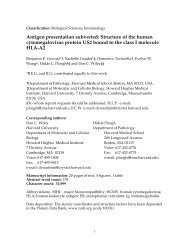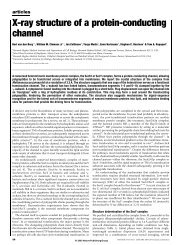Structure of the dengue virus envelope protein after membrane fusion
Structure of the dengue virus envelope protein after membrane fusion
Structure of the dengue virus envelope protein after membrane fusion
You also want an ePaper? Increase the reach of your titles
YUMPU automatically turns print PDFs into web optimized ePapers that Google loves.
articles<br />
have no particular sequence conservation. Indeed, <strong>the</strong> Ebola <strong>virus</strong><br />
<strong>fusion</strong> peptide begins at <strong>the</strong> 23rd residue <strong>of</strong> GP2, ra<strong>the</strong>r than at <strong>the</strong><br />
N terminus 39 , and a cysteine preceding <strong>the</strong> <strong>fusion</strong> peptide probably<br />
makes a disulphide bond with a cysteine C terminal to it. Thus,<br />
whatever its conformation, this peptide must enter and leave <strong>the</strong><br />
<strong>membrane</strong> from <strong>the</strong> external face. The available data for class I<br />
<strong>fusion</strong> peptides are thus consistent with one important feature <strong>of</strong><br />
our structure and <strong>of</strong> <strong>the</strong> SFV E1 post<strong>fusion</strong> structure 17 : insertion<br />
only into <strong>the</strong> outer bilayer leaflet.<br />
Insertion only into <strong>the</strong> outer leaflet is also consistent with <strong>the</strong><br />
requirement <strong>of</strong> a complete C-terminal trans<strong>membrane</strong> anchor on<br />
influenza HA or Simian <strong>virus</strong> 5 for full <strong>fusion</strong> to take place 40–42 .<br />
Indeed, as illustrated by Fig. 5f, one <strong>of</strong> <strong>the</strong> two <strong>membrane</strong> attachment<br />
structures must span <strong>the</strong> bilayer to stabilize a <strong>fusion</strong> pore. This<br />
appears to be <strong>the</strong> C-terminal anchor for both class I and class II<br />
<strong>fusion</strong>.<br />
Strategies for inhibiting flavi<strong>virus</strong> <strong>fusion</strong><br />
The discovery <strong>of</strong> a hydrophobic ligand-binding pocket beneath <strong>the</strong><br />
kl loop in <strong>the</strong> pre<strong>fusion</strong> structure <strong>of</strong> <strong>dengue</strong> sE has suggested one<br />
possible strategy for inhibiting flavi<strong>virus</strong> entry: by interfering with<br />
<strong>the</strong> <strong>fusion</strong> transition 10 . The rationale for that proposal is enhanced<br />
by our new structure, which shows that significant rearrangements<br />
do occur around <strong>the</strong> kl loop during <strong>the</strong> conformational change. The<br />
trimer structure also suggests a second strategy for interfering with<br />
<strong>fusion</strong>, related to an approach successful in developing an HIV<br />
antiviral compound 43 . Peptides corresponding to <strong>the</strong> C-terminal<br />
region <strong>of</strong> <strong>the</strong> gp41 ectodomain inhibit HIV-1 entry, probably by<br />
binding to <strong>the</strong> trimeric, N-terminal ‘inner core’ <strong>of</strong> <strong>the</strong> <strong>protein</strong> and<br />
interfering with <strong>the</strong> folding back against it <strong>of</strong> <strong>the</strong> C-terminal ‘outer<br />
layer’ 44 . An analogous strategy may be successful with class II viral<br />
<strong>fusion</strong> <strong>protein</strong>s, such as those <strong>of</strong> <strong>dengue</strong> and perhaps <strong>of</strong> hepatitis<br />
C. The way in which <strong>the</strong> stem is likely to fold back suggests that<br />
peptides derived from stem sequences could block completion <strong>of</strong><br />
<strong>the</strong> conformational change, by interacting with surfaces on <strong>the</strong><br />
clustered domains II. This would interfere with <strong>the</strong> final stage <strong>of</strong> <strong>the</strong><br />
conformational change, whereas targeting <strong>the</strong> pocket beneath <strong>the</strong> kl<br />
loop would interfere with <strong>the</strong> first stage. Inhibitors developed from<br />
<strong>the</strong>se two strategies could thus act in synergy.<br />
A<br />
Methods<br />
Expression and purification <strong>of</strong> <strong>dengue</strong> sE<br />
Soluble E <strong>protein</strong> (sE) from <strong>dengue</strong> <strong>virus</strong> type 2 S1 strain 45 was supplied by Hawaii<br />
Biotech. The <strong>protein</strong> was expressed in Drosophila melanogaster Schneider 2 cells (obtained<br />
from ATCC) using a pMtt vector (GlaxoSmithKline) containing <strong>the</strong> <strong>dengue</strong> 2 prM and E<br />
genes (nucleotides 539–2121), as previously described 46 . The resulting prM–E pre<strong>protein</strong><br />
is processed during secretion to yield sE, which was purified from <strong>the</strong> cell culture medium<br />
by immunoaffinity chromatography 47 .<br />
Preparation <strong>of</strong> <strong>dengue</strong> sE trimers<br />
Dengue sE trimers were obtained as follows, based on a method developed for TBE <strong>virus</strong><br />
sE 18 . 1-palmitoyl-2-oleoyl-sn-glycero-3-phosphocholine, 1-palmitoyl-2-oleoyl-snglycero-3-phosphoethanolamine<br />
(Avanti Polar Lipids) and 1-cholesterol (Sigma) were<br />
dissolved in chlor<strong>of</strong>orm, mixed in a 1:1:1 molar ratio, and dried under high vacuum for<br />
over 4 h. The lipid film was resuspended in 10 mM triethanolamine (TEA) <strong>of</strong> pH 8.3,<br />
0.14 M NaCl and subjected to five cycles <strong>of</strong> freeze-thawing, followed by 21 cycles <strong>of</strong><br />
extrusion through two 0.2 mm polycarbonate filter <strong>membrane</strong>s (Whatman). Purified sE<br />
was added in a 1:680 <strong>protein</strong>:lipid molar ratio and incubated at 37 8C for 5 min. The pH<br />
was lowered to endosomal levels by adding 75 mM MES <strong>of</strong> pH 5.4, and <strong>the</strong> <strong>protein</strong> was<br />
incubated at 37 8C for 30 min. Liposomes were solubilized with a 20-fold molar excess <strong>of</strong><br />
n-octyl-b-D-glucoside (b-OG) and 4 mM n-undecyl-b-D-maltoside (UDM) (Anatrace).<br />
Excess lipid was removed by cation exchange chromatography with MonoS (Pharmacia)<br />
in 25 mM citric acid <strong>of</strong> pH 5.26, 70 mM NaCl, 4 mM UDM. After washing with 0.4 M<br />
NaCl, <strong>the</strong> <strong>protein</strong> was eluted with 1–1.5 M NaCl. E trimers were fur<strong>the</strong>r purified by gel<br />
filtration on a Superdex 200 column (Pharmacia) in 8 mM TEA <strong>of</strong> pH 7, 80 mM NaCl,<br />
3 mM UDM. The sE trimers were concentrated to about 15 mg ml 21 for crystallization and<br />
dialysed against <strong>the</strong> gel filtration buffer using a 50-kDa molecular-mass cut<strong>of</strong>f <strong>membrane</strong><br />
(Spectrapor).<br />
Crystallization and data collection<br />
Crystals were grown at 20 8C by hanging-drop vapour dif<strong>fusion</strong> by mixing equal volumes<br />
<strong>of</strong> <strong>protein</strong> solution and <strong>the</strong> following reservoir solution: 20–30% polyethylene glycol 400<br />
(PEG400), 0.1 M MOPS pH 7–8 or Tris pH 8–9, 80 mM NaCl. Two crystal forms were<br />
obtained: plates <strong>of</strong> space group P321 with cell dimensions a ¼ b ¼ 76.2 Å, c ¼ 131 Å,and<br />
rhomboids <strong>of</strong> space group P3 2 21 with cell dimensions a ¼ b ¼ 153 Å, c ¼ 143 Å. The<br />
asymmetric unit <strong>of</strong> <strong>the</strong> P321 crystals contains one molecule <strong>of</strong> sE; that <strong>of</strong> <strong>the</strong> P3 2 21<br />
crystals, one trimer (three molecules) <strong>of</strong> sE. Cryoprotection was achieved by raising <strong>the</strong><br />
concentration <strong>of</strong> PEG400 to 30%. Crystals were frozen in liquid nitrogen, and all data were<br />
collected at 100 K on BioCARS beamline 14-BM-C at <strong>the</strong> Advanced Photon Source<br />
(Argonne National Laboratory). The data were processed with HKL 48 . Data collection<br />
statistics are presented in Supplementary Table 1.<br />
Chemical cross-linking<br />
sE was covalently cross-linked with ethylene glycol bis-(succinimidyl succinate) (EGS).<br />
10 mM–1 mM EGS was added from a fresh 0.1 M stock solution in dimethyl sulphoxide to<br />
about 5 mg E at 10 mgml 21 . Acidic solutions were neutralized with TEA <strong>of</strong> pH 8.5. After<br />
30 min at room temperature, EGS was quenched with 20 mM Tris for 15 min. Protein was<br />
precipitated with trichloroacetic acid and resuspended in SDS–polyacrylamide gel<br />
electrophoresis (PAGE) sample buffer for gel electrophoresis.<br />
Electron microscopy<br />
Dengue sE trimers inserted into liposomes were prepared as described above and adsorbed<br />
to glow-discharged, carbon-coated copper grids. Samples were washed with two drops <strong>of</strong><br />
deionized water, stained with two drops <strong>of</strong> 0.7% uranyl formate for 20 s, washed with<br />
water, and blotted gently. Micrographs were recorded on a Philips Tecnai 12 electron<br />
microscope at 100 kV and 64,000-fold magnification.<br />
<strong>Structure</strong> determination<br />
The crystal structure <strong>of</strong> <strong>dengue</strong> E in <strong>the</strong> post<strong>fusion</strong> conformation was determined by<br />
molecular replacement using individual domains from <strong>the</strong> pre<strong>fusion</strong> <strong>dengue</strong> E structure 10<br />
(Protein Data Bank code 1OKE) as search models, and <strong>the</strong> P321 data set (see<br />
Supplementary Table 1). Domain II was placed first, followed by domain I, with AmoRe 49 .<br />
Domain III was placed last, with CNS 50 . The atomic coordinates <strong>of</strong> <strong>the</strong> three domains were<br />
refined as rigid bodies. The model was rebuilt with O 51 based on 2F o – F c and F o –F c<br />
Fourier maps. Residues 1–17, 34–40, 49–54, 128–137, 165–192, 290–299 and 341–346<br />
were built de novo. Coordinates were <strong>the</strong>n refined against data up to 2.0 Å resolution by<br />
simulated annealing using torsion-angle dynamics with CNS 50 , and rebuilt with O, in<br />
iterative cycles. Later cycles included restrained refinement <strong>of</strong> B-factors for individual<br />
atoms and energy minimization against maximum likelihood targets with CNS. The final<br />
model contains residues 1–144 and 159–394, an n-acetyl glucosamine glycan on residue<br />
67, 205 water molecules and one chloride ion. Residues 145–158 and <strong>the</strong> glycan on residue<br />
153 are disordered.. Refinement statistics are presented in Supplementary Table 1.<br />
Received 16 August; accepted 24 October 2003; doi:10.1038/nature02165.<br />
1. Skehel, J. J. & Wiley, D. C. Receptor binding and <strong>membrane</strong> <strong>fusion</strong> in <strong>virus</strong> entry: <strong>the</strong> influenza<br />
hemagglutinin. Annu. Rev. Biochem. 69, 531–569 (2000).<br />
2. Wilson, I. A., Skehel, J. J. & Wiley, D. C. <strong>Structure</strong> <strong>of</strong> <strong>the</strong> haemagglutinin <strong>membrane</strong> glyco<strong>protein</strong> <strong>of</strong><br />
influenza <strong>virus</strong> at 3 Å resolution. Nature 289, 366–373 (1981).<br />
3. Baker, K. A., Dutch, R. E., Lamb, R. A. & Jardetzky, T. S. Structural basis for paramyxo<strong>virus</strong>-mediated<br />
<strong>membrane</strong> <strong>fusion</strong>. Mol. Cell 3, 309–319 (1999).<br />
4. Melikyan, G. B. et al. Evidence that <strong>the</strong> transition <strong>of</strong> HIV-1 gp41 into a six-helix bundle, not <strong>the</strong><br />
bundle configuration, induces <strong>membrane</strong> <strong>fusion</strong>. J. Cell Biol. 151, 413–423 (2000).<br />
5. Russell, C. J., Jardetzky, T. S. & Lamb, R. A. Membrane <strong>fusion</strong> machines <strong>of</strong> paramyxo<strong>virus</strong>es: capture<br />
<strong>of</strong> intermediates <strong>of</strong> <strong>fusion</strong>. EMBO J. 20, 4024–4034 (2001).<br />
6. Bullough, P. A., Hughson, F. M., Skehel, J. J. & Wiley, D. C. <strong>Structure</strong> <strong>of</strong> influenza haemagglutinin at<br />
<strong>the</strong> pH <strong>of</strong> <strong>membrane</strong> <strong>fusion</strong>. Nature 371, 37–43 (1994).<br />
7. Chen, J., Skehel, J. J. & Wiley, D. C. N- and C-terminal residues combine in <strong>the</strong> <strong>fusion</strong>-pH influenza<br />
hemagglutinin HA(2) subunit to form an N cap that terminates <strong>the</strong> triple-stranded coiled coil. Proc.<br />
Natl Acad. Sci. USA 96, 8967–8972 (1999).<br />
8. Rey, F. A., Heinz, F. X., Mandl, C., Kunz, C. & Harrison, S. C. The <strong>envelope</strong> glyco<strong>protein</strong> from tickborne<br />
encephalitis <strong>virus</strong> at 2 Å resolution. Nature 375, 291–298 (1995).<br />
9. Lescar, J. et al. The <strong>fusion</strong> glyco<strong>protein</strong> shell <strong>of</strong> Semliki Forest <strong>virus</strong>: an icosahedral assembly primed<br />
for fusogenic activation at endosomal pH. Cell 105, 137–148 (2001).<br />
10. Modis, Y., Ogata, S., Clements, D. & Harrison, S. C. A ligand-binding pocket in <strong>the</strong> <strong>dengue</strong> <strong>virus</strong><br />
<strong>envelope</strong> glyco<strong>protein</strong>. Proc. Natl Acad. Sci. USA 100, 6986–6991 (2003).<br />
11. Allison, S. L. et al. Oligomeric rearrangement <strong>of</strong> tick-borne encephalitis <strong>virus</strong> <strong>envelope</strong> <strong>protein</strong>s<br />
induced by an acidic pH. J. Virol. 69, 695–700 (1995).<br />
12. Ferlenghi, I. et al. Molecular organization <strong>of</strong> a recombinant subviral particle from tick-borne<br />
encephalitis <strong>virus</strong>. Mol. Cell 7, 593–602 (2001).<br />
13. Kuhn, R. J. et al. <strong>Structure</strong> <strong>of</strong> <strong>dengue</strong> <strong>virus</strong>: implications for flavi<strong>virus</strong> organization, maturation, and<br />
<strong>fusion</strong>. Cell 108, 717–725 (2002).<br />
14. Allison, S. L., Schalich, J., Stiasny, K., Mandl, C. W. & Heinz, F. X. Mutational evidence for an internal<br />
<strong>fusion</strong> peptide in flavi<strong>virus</strong> <strong>envelope</strong> <strong>protein</strong> E. J. Virol. 75, 4268–4275 (2001).<br />
15. Levy-Mintz, P. & Kielian, M. Mutagenesis <strong>of</strong> <strong>the</strong> putative <strong>fusion</strong> domain <strong>of</strong> <strong>the</strong> Semliki Forest <strong>virus</strong><br />
spike <strong>protein</strong>. J. Virol. 65, 4292–4300 (1991).<br />
16. Ahn, A., Gibbons, D. L. & Kielian, M. The <strong>fusion</strong> peptide <strong>of</strong> Semliki Forest <strong>virus</strong> associates with sterolrich<br />
<strong>membrane</strong> domains. J. Virol. 76, 3267–3275 (2002).<br />
17. Gibbons, D. L. et al. Conformational change and <strong>protein</strong>–<strong>protein</strong> interactions <strong>of</strong> <strong>the</strong> <strong>fusion</strong> <strong>protein</strong> <strong>of</strong><br />
Semliki Forest <strong>virus</strong>. Nature 427, 320–325 (2004).<br />
18. Stiasny, K., Allison, S. L., Schalich, J. & Heinz, F. X. Membrane interactions <strong>of</strong> <strong>the</strong> tick-borne<br />
encephalitis <strong>virus</strong> <strong>fusion</strong> <strong>protein</strong> E at low pH. J. Virol. 76, 3784–3790 (2002).<br />
19. Wimley, W. C. & White, S. H. Partitioning <strong>of</strong> tryptophan side-chain analogs between water and<br />
cyclohexane. Biochemistry 31, 12813–12818 (1992).<br />
20. Allison, S. L., Stiasny, K., Stadler, K., Mandl, C. W. & Heinz, F. X. Mapping <strong>of</strong> functional elements in <strong>the</strong><br />
stem-anchor region <strong>of</strong> tick-borne encephalitis <strong>virus</strong> <strong>envelope</strong> <strong>protein</strong> E. J. Virol. 73, 5605–5612 (1999).<br />
318<br />
© 2004 Nature Publishing Group<br />
NATURE | VOL 427 | 22 JANUARY 2004 | www.nature.com/nature






